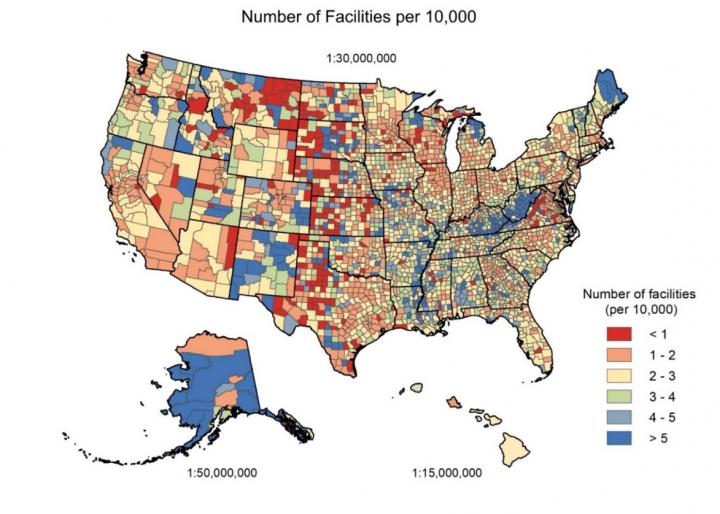University of Pittsburgh School of Pharmacy and West Health Policy Center develop mapping-tool to identify counties where residents may face access issues

Credit: West Health Policy Center and the University of Pittsburgh School of Pharmacy
WASHINGTON, DC – DEC. 16, 2020 — As the biggest vaccination effort in U.S. history gets underway, several states may not have a sufficient number of facilities in some areas to administer the COVID-19 vaccine to all residents who want it, according to a new analysis from the University of Pittsburgh School of Pharmacy and the nonprofit West Health Policy Center.
In what is believed to be the first county-level analysis of the nation’s potential COVID-19 vaccine facilities, which include community pharmacies, federally qualified health centers, hospital outpatient departments and rural health clinics, the researchers found that more than a third (35%) of U.S. counties have two or fewer of these facilities and nearly 1 in 10 counties have fewer than one facility per 10,000 residents.
The analysis, including an interactive, open-access map, titled VaxMap, and white paper, was published online today by West Health.
“The U.S. has large geographic variation in population access to potential COVID-19 vaccine administration facilities, particularly at the county level,” said Inmaculada Hernandez, Pharm.D., Ph.D., Assistant Professor at the Pitt School of Pharmacy and senior author of the study.
“This highlights the need for state and local public health officials to tailor their vaccine distribution and administration plans to their specific populations and the current limitations of their state’s existing healthcare infrastructure,” said Lucas Berenbrok, Pharm.D., Assistant Professor at the Pitt School of Pharmacy and first author of the study.
Researchers used geographic information system (GIS) software to map more than 70,000 potential COVID-19 vaccine administration facilities and calculate the average driving distance to the closest facility for simulated citizens, including high-risk populations such as people age 65 or older.
The counties with the fewest vaccination facilities relative to the size of their populations are located in Texas, Kansas, Nebraska, Montana and Virginia. When it comes to driving distance, residents of North Dakota, South Dakota, Montana, Wyoming, Nebraska, and Kansas face the longest drives, with over 10% living more than 10 miles away from the closest facility.
For older adults it’s even worse. In 12% of counties, at least half of the older population have a more than 10-mile drive. In North and South Dakota, 25% of older adults are more than 10 miles away from a facility.
“We did the analysis to help states and counties throughout the U.S. identify potential problem areas for vaccine administration and enact effective strategies and take measures to overcome them,” said Tim Lash, President of the West Health Policy Center. “Clearly there are certain spots throughout the country that need more help and support than others.”
The researchers suggest that state and local authorities in areas with short driving distances and low facility density may consider adding mass vaccination clinics to increase capacity and reduce the time to vaccinate. Conversely, areas with high driving distances may benefit from mobile vaccination clinics to reduce travel-related barriers, and vaccines that require only one dose instead of two may be more effective in ensuring sufficient vaccine uptake.
“Facility density and distance metrics can guide state officials not only in identifying the most appropriate strategy to increase capacity and convenience in each locality, but also in vaccine selection,” said paper co-author Sean Dickson, Director of Health Policy, West Health Policy Center. “When large populations are served by only a few vaccine administration points, additional support to store and dispense vaccine will be needed.”
###
About the West Health Policy Center and West Health
Solely funded by philanthropists Gary and Mary West, West Health
is a family of nonprofit and nonpartisan organizations including the Gary and Mary West Foundation
and the Gary and Mary West Health Institute
in San Diego, and the Gary and Mary West Health Policy Center
in Washington, D.C. West Health is dedicated to lowering healthcare costs to enable seniors to successfully age in place with access to high-quality, affordable health and support services that preserve and protect their dignity, quality of life and independence.
Learn more at westhealth.org and follow
@WestHealth.
About the University of Pittsburgh School of Pharmacy
The University of Pittsburgh School of Pharmacy
has been developing leaders who have been driving the future of pharmacy for over 135 years. We investigate, discover and create ways to improve patient health and, through partnerships, change practice and improve efficiency of care. Pitt Pharmacy ranks
in the top ten in NIH-funded research and in the top fifteen in U.S. News and World Report among schools of pharmacy.
The School of Pharmacy leads the way in education, personalizing education and getting students to expert faster. Chartered in 1878, the School of Pharmacy is among the oldest pharmacy schools in the country.
Media Contact
Aimee Brierly
[email protected]
Original Source
https:/




